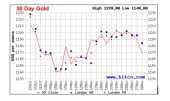 The voters of Switzerland have rejected the “Save Our Swiss Gold” initiative, a political effort to force that country’s central bank to buy thousands of tons of the stuff, in order to bring gold’s portion of that institution’s over-all assets up to 20%.
The voters of Switzerland have rejected the “Save Our Swiss Gold” initiative, a political effort to force that country’s central bank to buy thousands of tons of the stuff, in order to bring gold’s portion of that institution’s over-all assets up to 20%.
At almost the same time as voters were heading to the polls, the price of gold headed sharply down. There exists a temptation in some quarters to connect those dots. It is best to resist that temptation.
Markets look relentlessly ahead. They aren’t at all nostalgic. Nor do they live in the “now.” They’re discounting machines. And the key thing to know about the failure of the Swiss initiative is that it had already been discounted days before the votes were cast.
The place to look for the downward move this weekend is not in the Alps, but in the corridors of power in Riyadh, Saudi Arabia.
Recent History
But let’s review, because this is a fascinating case study in how financial markets do and don’t work. For three years now, the Swiss National Bank has followed a policy of watching the euro/franc exchange rate, and putting a floor beneath the euro, buying enough of them so that the euro does not fall below 1.20 CHF.
It has followed this course despite the fact that the ECB has been aggressively cutting interest rates, weakening its own currency against the pound and the dollar.
Unsurprisingly, then, the SNB’s holdings have come to be dominated by these devalued euros. They now constitute half of the SNB’s assets. This is the circumstance that angered the Swiss People’s Party in particular, and that inspired the initiative campaign.
In early October 2014 gold dipped briefly below $1,200 an ounce. Then it rose steadily for three weeks, hitting $1,250 on the 20th, before turning around and heading down again. Although there are always a number of factors involved on both the supply and the demand sides, at least part of the explanation for recent movements has been the market’s efforts to anticipate the politics of this initiative. Mr. Market can do the math. Had Switzerland been forced to buy gold in the quantity contemplated by the initiative, never mind repatriation and other measures included, that run-up to $1,250 would have been more than justified.
Politics and Crude Oil
But Mr. Market can also keep track of publicly expressed political sentiments pretty well. By early November the temperament in Switzerland was turning against the gold-buying plan, driven by (sensible) concerns about the consequences for Swiss exporters. The market reflected this change in mood, and the price of gold headed down, breaking below $1,150 an ounce on November 5th. This figure may represent the market’s full discounting of the fact that the political tide had by then turned against the Swiss People’s Party. It continued to turn against the SPP in the days that followed.
By Election Day sentiment was so decisively against this initiative, in fact, that the vote on Sunday, November 30, seemed an anti-climax: 77.3% of those voting opposed the idea. A separate vote on immigration received a lot more attention.
Against this background, it seems evident that the upward ticks of the price of gold in the days after November 6th,, ticks that had it bumping its head against the $1,200 ceiling, had other causes. Information is like gasoline – you only burn it up once. The gasoline that I burnt driving my car yesterday will play no part in my travels today. Likewise, Swiss politics, burnt up in the trading on both sides of the start of November, likely had nothing to do with the trading in the second or third weeks of the month. By then, as it happens, other factors [notably a jump in India’s imports] had brought gold up from its early-November valley.
Likewise, I submit, it is reasonable to doubt that the drop in gold’s value over the final weekend of November had anything to do with Switzerland’s by-now expected rejection of this initiative.
A more likely catalyst? The slump in oil prices in general and the crash of oil futures on Friday in particular. Gold has historically served as a hedge against inflation, and more recently it has served as a hedge against Middle Eastern crises. The two considerations are one, because the continued weakness of oil prices has buffered the world’s key currencies against the effects of all the quantitative easing their central banks have been up to. So … it isn’t a surprise that evidence the weakness of oil prices will continue in turn contributed to another drop in the price of gold.



